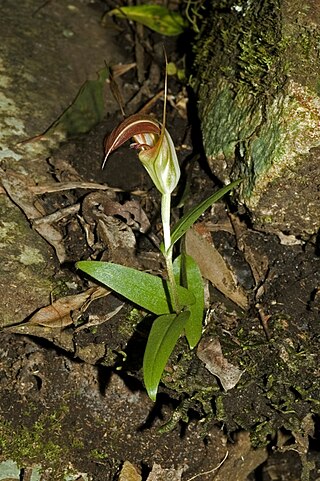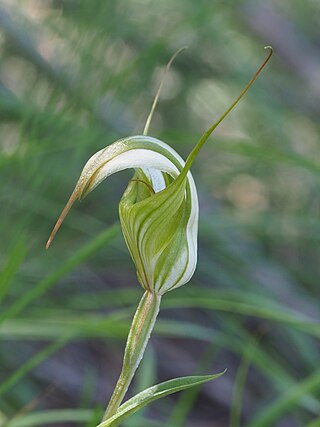
Pterostylis coccina, commonly known as the scarlet greenhood, is a species of orchid endemic to eastern Australia. As with similar greenhoods, the flowering plants differ from those which are not flowering. The non-flowering plants have a rosette of leaves flat on the ground but the flowering plants have a single flower with leaves on the flowering spike. In this species, the rosette leaves are relatively large and dark green, and the flowers are white, and bluish-green or red. It grows in New South Wales and north-eastern Victoria.

Pterostylis grandiflora, commonly known as the cobra greenhood or superb greenhood, is a species of orchid endemic to south-eastern Australia. As with similar orchids, the flowering plants differ from those which are not flowering. The non-flowering plants have a rosette of leaves but the flowering plants lack a rosette and have a single flower with leaves on the flowering spike. This greenhood has a green and white, striped flower with deep red-brown markings especially on its "galea", and a sharply pointed dorsal sepal.

Pterostylis fischii, commonly known as Fisch's greenhood, is a species of orchid endemic to south-eastern Australia. As with similar greenhoods, the flowering plants differ from those which are not flowering. The non-flowering plants have a rosette of leaves flat on the ground but the flowering plants have a single flower with leaves on the flowering spike. This greenhood has tawny-coloured flowers, a dorsal sepal with a long thread-like tip and a labellum which is hidden inside the flower.

Pterostylis atrans, commonly known as the dark-tip greenhood or blunt-tongue greenhood, is a species of orchid endemic to south-eastern Australia. As with similar greenhoods, plants in flower differ from those that are not flowering. The non-flowering plants have a rosette of leaves flat on the ground, but the plants in flower have a single flower with leaves on the flowering spike. In this species, the flower is green and reddish brown with a protruding sinus and small club-like tips on the ends of the lateral sepals.

Pterostylis revoluta, commonly known as the autumn greenhood, is a species of orchid endemic to south-eastern Australia. As with similar greenhoods, the flowering plants differ from those which are not flowering. The non-flowering plants have a rosette of leaves flat on the ground but the flowering plants have a single flower with leaves on the flowering spike. This greenhood has white and green flowers that have a long, curved, pointed labellum which extends beyond the sinus between the lateral sepals.

Pterostylis aneba is a species of orchid endemic to south-eastern Australia. It is a recently described and poorly-known greenhood similar to Pterostylis alpina and P. monticola. It has a rosette of fleshy leaves at the base of the plant and a single green and white flower. It grows in alpine and sub-alpine habitats.

Pterostylis laxa, commonly known as the antelope greenhood, is a species of orchid endemic to south-eastern Australia. As with similar greenhoods, the flowering plants differ from those which are not flowering. The non-flowering plants have a rosette of leaves flat on the ground but the flowering plants have a single flower with leaves on the flowering spike. This greenhood has green and white flowers with darker green or brown markings and a dorsal sepal with a long thread-like tip.

Pterostylis longipetala, commonly known as the curved greenhood, is a species of orchid endemic to eastern Australia. As with similar greenhoods, the flowering plants differ from those which are not flowering. The non-flowering plants have a rosette of leaves flat on the ground but the flowering plants have a single flower with leaves on the flowering spike. This greenhood has dark green, brown and white flowers which lean slightly forwards and have sharply-pointed petals and a long, curved labellum.

Pterostylis multiflora, commonly known as the tall tiny greenhood, is a species of orchid endemic to south-eastern Australia. As with similar orchids, plants in flower differ from those that are not. Those not in flower have a rosette of leaves lying flat on the ground. Plants in flower lack a rosette but have up to twenty tiny green, white, and brown flowers in summer. The flowering stem has up to six stem leaves.

Pterostylis striata, commonly known as the mainland striped greenhood, is a species of orchid endemic to south-eastern mainland Australia. As with similar orchids, the flowering plants differ from those which are not flowering. The non-flowering plants have a rosette of leaves but the flowering plants have a single flower with leaves on the flowering spike. This greenhood has a white flower with prominent dark green stripes and a brown-tipped dorsal sepal with a thread-like tip. Mainland striped greenhoods were formerly described as Pterostylis alata but that species is now recognised as a Tasmanian endemic.

Pterostylis rubescens, commonly known as the blushing tiny greenhood, is a species of orchid endemic to south-eastern Australia. As with similar orchids, the flowering plants differ from those which are not flowering. The non-flowering plants have a rosette of leaves but the flowering plants lack a rosette at the base and have up to eighteen tiny green, white and brownish flowers.
Pterostylis bryophila, commonly known as the Hindmarsh Valley greenhood, is a species of orchid endemic to South Australia. As with similar greenhoods, plants in flower differ from those that are not. In this species, plants not in flower have a rosette of leaves lying flat on the ground, but those in flower have a single small, shiny, bright green and white flower with a protruding, platform-like sinus between the lateral sepals.

Pterostylis elegans, commonly known as the elegant greenhood, is a species of orchid endemic to New South Wales. Non-flowering plants have a rosette of leaves flat on the ground but flowering plants have a single translucent white and dark green flower with reddish-brown markings near the tip.
Pterostylis nigricans, commonly known as the dark greenhood, is a species of orchid endemic to eastern Australia. As with similar orchids, the flowering plants differ from those which are not flowering. The non-flowering plants have a rosette of leaves but the flowering plants lack a rosette at the base but have up to six tiny green, white and brown flowers which have a rough texture.

Pterostylis pulchella, commonly known as the waterfall greenhood, escarpment greenhood or pretty greenhood is a species of orchid endemic to New South Wales. As with similar greenhoods, the flowering plants differ from those that are not flowering. The non-flowering plants have a rosette of leaves flat on the ground but the flowering plants have a single flower with leaves on the flowering stem. This greenhood has a reddish-brown flower with a greenish-white base and protruding labellum with a cleft tip.

Pterostylis reflexa, commonly known as the dainty greenhood, is a species of orchid endemic to New South Wales. As with similar greenhoods, the flowering plants differ from those which are not flowering. The non-flowering plants have a rosette of leaves flat on the ground but the flowering plants have a single flower with leaves on the flowering stem. This greenhood has a relatively large white, green and light brown flower with a long, curved dorsal sepal and a protruding labellum.
Pterostylis riparia, commonly known as the streamside greenhood, is a plant in the orchid family Orchidaceae and is endemic to New South Wales. Both flowering and non-flowering plants have a rosette of dark green, fleshy leaves. Flowering plants have a single, relatively large green, white and reddish-brown flower with a deeply notched sinus between hairy lateral sepals.
Pterostylis saxicola, commonly known as the Sydney plains rustyhood, or Sydney plains greenhood, is a plant in the orchid family Orchidaceae and is endemic to New South Wales. It has a rosette of leaves at its base and up to ten reddish-brown flowers with translucent "windows", relatively wide lateral sepals with short-pointed tips and a dark brown, fleshy, insect-like labellum.

Pterostylis vernalis, commonly known as the spring tiny greenhood, is a species of orchid endemic to New South Wales. As with similar orchids, the flowering plants differ from those that are not currently flowering. Non-flowering plants have a rosette of leaves at the base. Flowering plants lack that rosette, but have one or two rosettes on lateral growths. The flowers are green, brown and white. This greenhood is only known from a small area near Nowra.
Pterostylis rubiginosa is a species of orchid endemic to northeastern New South Wales. Flowering and non-flowering plants have a rosette of leaves that is withered by the time flowering occurs. Flowering plants have up to seven white flowers with rusty brown stripes, on a wiry flowering stem.















